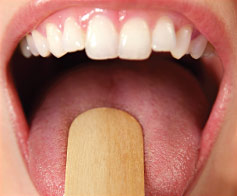Bad Breath
More than Just Embarrassing
(Continued)
Halitosis — Figuring Out The Cause Of Bad Breath
It must be emphasized that halitosis per se is not a diagnosis — it is a sign to the dentist or in some cases a symptom described by the patient. It is the responsibility of the dentist to diagnose the underlying cause of halitosis. Oral malodor is a condition affecting millions of Americans: while it is always easy to recognize halitosis, identifying the exact cause is more complex. Your health professional, dentist or physician will use a more systematic approach to determine the cause.
The doctor's first step is to obtain a thorough history:
- The chief complaint: Is the bad breath objective, noticeable by the dentist, family member or significant other, or the subjective complaint only of the individual?
- Medical history: Are there any ear, nose, throat or lung problems? Are there any gastrointestinal problems? What medications is the patient using? Does the patient have any allergies? Are the kidneys and liver functioning normally (the main clearing houses of the body)?
- Diet history: Are garlic, onions or other pungent foods part of the customary diet?
- Psychosocial assessment: Does the patient suffer from depression, anxiety or lifestyle issues, such as sleep or work problems?
- Personal habits: Does the patient smoke and what form — cigarettes, pipe or cigar? Does the person habitually consume alcohol-containing beverages?

Next, the dentist will perform an oral examination and look for decayed or abscessed teeth, diseased gums, coated tongue or infected tonsils.
Following an oral examination, the next step may be breath tests to determine if the odor emanates from the mouth and throat (oral origin) or lungs (bodily origin):
- The person blows forcibly through the nostrils while the mouth is closed. If offensive odor is detectable, it has a systemic (general or bodily) cause.
- The person closes the nostrils by pinching with their fingers and ceases breathing momentarily, with lips tightly closed. While the nose is still closed the person opens their lips and exhales gently. If malodor is noticeable, it is of local, oral origin.
In some cases both local and systemic bodily causes may contribute to offensive breath.
If bad breath is persistent, and all other medical and dental factors have been ruled out, specialized testing and treatment are required. Hundreds of dental offices and commercial breath clinics now claim to diagnose and treat bad breath. They often use one of several laboratory methods for measurement of VSCs to diagnose bad breath. The most practical measurement of bad breath, “the gold standard,” is simply the actual sniffing and scoring of the level and type of odor carried out by trained experts.
Treating Bad Breath
Treatment will depend very much on the diagnosis of the cause of halitosis. Treatment may be as simple as oral hygiene instruction, or more involved techniques such as scaling, root planing (deep cleaning), the use of antibiotics to treat offending bacteria — all followed by regular maintenance visits. These treatments or therapies might be performed by the general dentist or when necessary by a periodontist, a specialist in gum diseases. The aim of treatment is to create a healthier oral ecology by promoting more protective bacteria.
If the halitosis originates from the mouth, then the local treatment of the offending tooth or teeth, decay, periodontal disease, dry socket from an extraction or operculum (loose gum flap covering) over a wisdom tooth, is mandatory. Studies have shown that periodontal therapy reduces volatile sulphur compounds, VSCs, by 40-60%. Removing the bacterial coating on the back of the tongue with tongue scrapers or brushes reduces the amount of VSCs in the mouth air. However, if only the tongue is cleaned and no periodontal treatment is instituted, VSC levels rise again. Mouth rinses only help temporarily unless the underlying disease is also treated.
If halitosis is of systemic origin appropriate medical and/or surgical intervention may be needed.
Conclusion
When it comes to bad breath, time spent in careful diagnosis is time well spent. The results of a dentist's examination will determine which treatment is best, and how extensive that treatment should be.
More importantly, getting to the root cause of bad breath may reveal a more serious condition, and the need for referral to an appropriate specialist. In those cases, treating a case of bad breath may just be a lifesaver.




